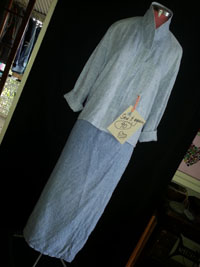 Upcycling natural fibre clothing for a second life makes sense – for the planet, the hip-pocket and personal satisfaction.
Upcycling natural fibre clothing for a second life makes sense – for the planet, the hip-pocket and personal satisfaction.
There’s recreation to be had in recreating new garments out of old. It is fun engaging one’s creative and thrifty instincts, exploring and playing with textures and techniques … but it does require a willingness and flexibility to invest time in the process.
One of the most valuable things about having basic sewing skills is the independence and individuality they provide. You are not restricted to what’s currently trendy and newly available online or in shops.
The essence of Sew 101 is being empowered, sustainable and creative. I made this simple top and skirt years ago from Italian lycra (not a natural fibre I know, but so interesting). These casual separates served me well but I was no longer wearing them. From my op-shop stash I found a sheer silk shirt in complementary colours and merged the two to create a one-off.
Even as I filleted the silk shirt by cutting off the sleeves, the collar and rectangular panels from the body, I appreciated the high quality craftsmanship of the maker (it was a Liz Davenport, a leading designer from Western Australia).
I left all the fastenings and features in place, arranging and then sewing various pieces to the lycra base. The silk pieces float and drape from where they are anchored to the lycra with machine or hand stitching. Lycra doesn’t fray, so I cut into the sleeve and neckline without needing to neaten it. I kept fiddling, adding and subtracting until I’d had enough yesterday afternoon – and this is the result.











